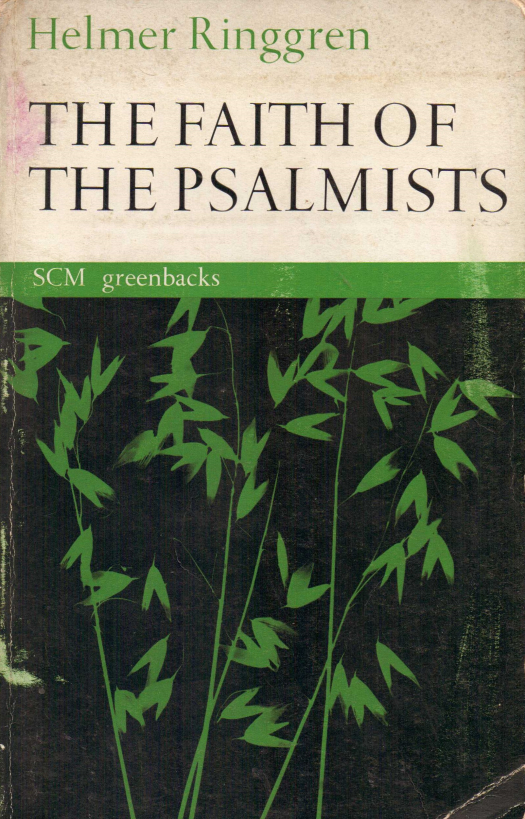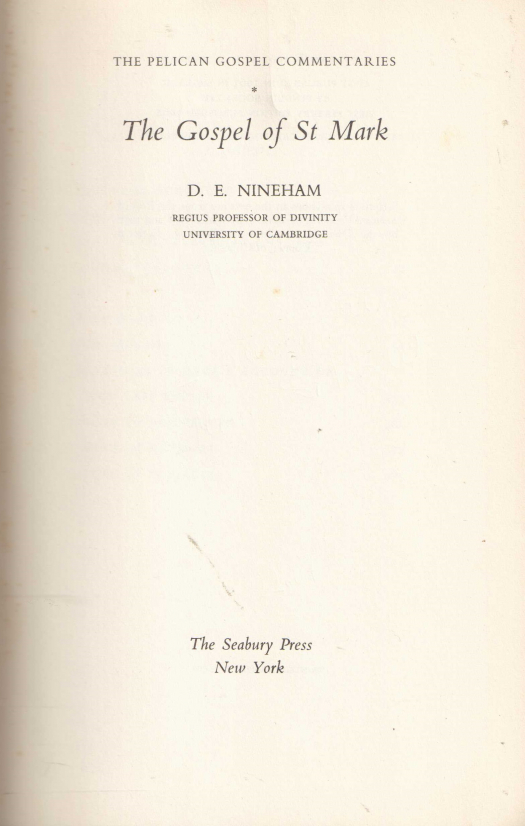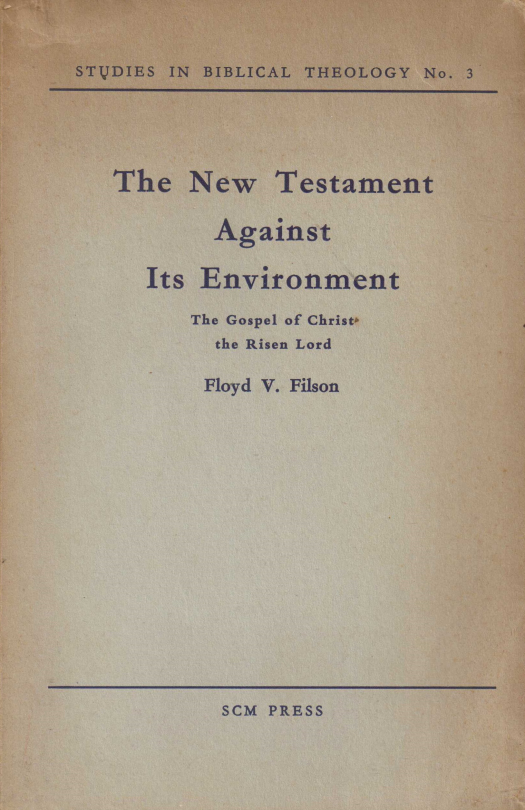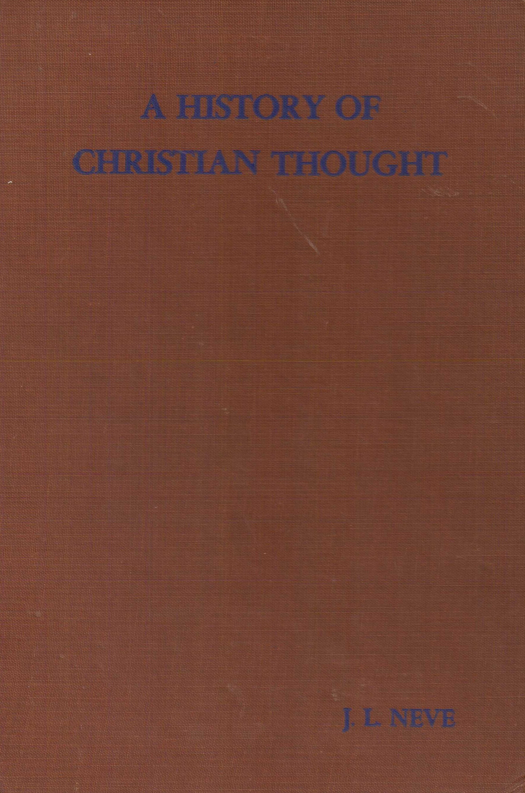The faith of the psalmists / Helmer Ringgren - Donación Ana Rita, Carlos, Rubén Pagura Alegría
No part of the Old Testament is more used todat than the Psalms, and no part has been more brilliantl illuminated by the modern scholars. Dr. Ringgren sums up the international scholarly discussion in a way which is both judicious and intelligible. The author was trained, and taught, in the University of Uppsala in Sweden, and is now a professor in the University of Turku in Finland. He has also been a professor in the USA, and himself translated and revised this English edition of the Swedish Psaltarens Fromhet.
Cultic element. Religion of fellowship. Theocentric religion. Righteous and the wicked. Concept of God. Lament and confession. Thanksgiving and praise. Myth and history. Law and the messiah.
U15176
The gospel of St. Mark / D. E. Nineham - Donación Ana Rita, Carlos, Rubén Pagura Alegría
A book such as this, which comes out of many years' reflection on the Gospels, owes so much to so many that it would be impracticable to give a complete list of all my obligations, even were I consciously aware of them all. My chief obligations to previous writers and commentators on St. Mark are acknowledged in the Introduction and notes, but certain more personal obligations it is a pleasure to record here.
U15166
The New Testament against its environment : the gospel of Christ, the risen Lord / Floyd V. Filson - Donación Ana Rita, Carlos, Rubén Pagura Alegría
In april, 1949, Profesor G. Ernest Wright and I gave the Haskell Lecturaes at Oberlin College, Oberlin, Ohio. We took as our subject "The Bible Against Its Environment". Professor Wirght's three lectures were given unver the subtitle "The God of Israel and the Gods of the Nations". They contrasted the Old Testament with its environment by studies dealing successively with God, history, and the life of God's people. My own lectures, a study of the New Testasment under the subtitle, "The Gospel of Christ the Risen Lord", took up in turn the same three themes. The question which I undertook to answer was: How far does the New Testament present a content which is distint and different from the non-Christian religious life and writings of New Testament times?
It may be asked why I stated the contrast between the New Testament and its environment in termes of "The Gospel of Christ The Risen Lord". In these words I tried to lay hold of the common and vital content of the entire New Testament.
U15165
A history of christian thought / J. L. Neve - Donación Ana Rita, Carlos, Rubén Pagura Alegría
The history in doctrine, or in wider conception the History of Christian Tought, is a study of great importance for theologians and pastors. It came into existence about the beginning of the nineteenth century. At that time of rationalism its purpuse was to show that the confessional heritage of the church could not be mantained. But soon, with the revival of evangelical theology, the conservatives also adopted this branch and put into the service of theological conservatism.
V.1 - Book One: the ancient church. Introductory matters. Precursory thought. Christianity of the post-apostolic fathers. Greek apologists. Perversions of christianity. Source and norm of truth, or fundation of the dogma. Episcopate as guardian of the truth and the christian life. Early ideas of the church. Old catholic theologians. First steps into the ecumenical age. Doctrine of the trinity. Doctrine of two natures and one person in Christ. Problems of anthropology and soteriology. Sacraments. Concluding observations: the christianity of the east and of the west. V.1 - Book two: the middle ages. theology of Gregory the Great. Development of papal supremacy. Awakening of the new piety. Beginning and rise of scholantism. Doctrinal issues in the eleventh and twelfth centuries. Church and theology in the thirtheeth century. Teaching of sin and grace. Sacraments. Church and state in the fourteenth and fifteenth centuries. Theology and piety in the later middle ages. V.1 - Book Three: the reformation. Luther as reformer. Zwingli and his theology. First conflict over the Lord's Supper. Melanchton the colaborer or Luther. Earliest confessional writings of lutheranism. Bucer, Calvin, and the confessional standards of lutheranism. Controversies in the lutheran church and their settlement in the formula of concord. Age of strict orthodoxy in the lutheran church. Doctrinal development within roman catholic theology. V.2 - Book Four: deveopments in post-reformation theology. George Calixtus and the principles of syncretism. Arminianism in Holland. Arminianism in England. Theology of the "inner light". English deists: first steps in radical liberalism. French naturalists of the seventeenth and eighteenth centuries. German racionalism. Old socinians or unitarians. V.2 - Book Five: New attitudes to religion and christianity. Immanuel Kant: his ideas on religion. German indelism and its relation to christianity. Scheliermacher. Theology and theologians under the inflluence of Hegel's philosophy. Confessional thology. Mediating theology: the biblists. Neo-kantianism and the ritschilan theology. From Ritschl to Barth. Theological thought between the two great wars. Introdudtory remarks. Early evangelical and the early orthodox parties. Coleridge: the early Oriel school. Oxford Movement. Philosophy and the negative movement. Consolidation of liberal forces. Scottish thology. Non-conformist theology. Theological development in the anglican church. British philiosophy. from 1860 to present. Theological movements in the twentieth century: the liberal protestant, and catholic traditions. Facts ans forces in american theology. Philosophical thought in America. New England theology: Jonathan Edwards and his school. Liberal movement in american theology. Conservative forces in american calvinism during the nineteenth century. Lutheran theology. Twentieth century.
U15163 - U15164





